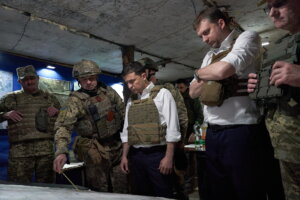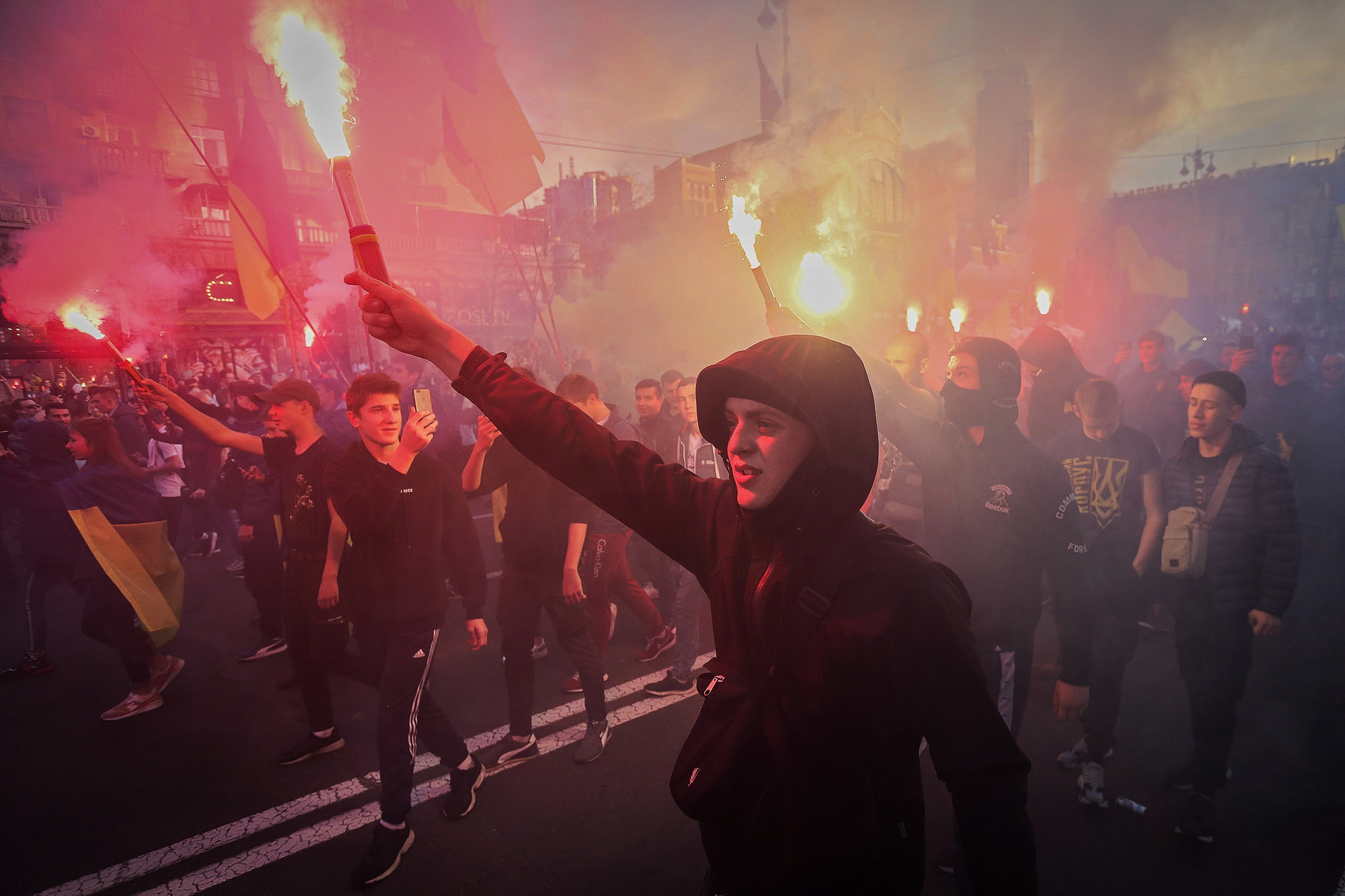President Volodymyr Zelensky was hardly specific with campaign promises. But bringing peace to Ukraine’s war-torn east was among the few explicit promises that secured him a landslide victory over hawkish President Petro Poroshenko.
After taking office in May, Zelensky quickly made moves on his promise to bring peace to Donbas.
In the following months, the Ukrainian army and Russian-backed militants for the first time pulled back their heavy weapons in one of the hottest spots of the front line. The first prisoner exchange in two years followed, bringing 35 Ukrainian captives back home from Russia.
Finally, in early October, Zelensky agreed to the so-called Steinmeier Formula – a peace plan promising the occupied regions self-governance after they hold local elections under Ukrainian law.
After four years with no active peace talks, it was a breakthrough.
Then, it stalled. The next step, another rollback of the troops, can’t happen because of unending fire.
Zelensky’s peace plan got stuck in limbo due to lack of co-operation from Russia, which was initially supportive of the Ukrainian president’s initiative.
Meanwhile, the peace plan has been facing domestic opposition, with Zelensky’s political rivals, trying to spin it as a failure. To strengthen his positions at home, Zelensky needs quick results.
Impossible ceasefire
Zelensky first explained his peace plan in mid-September, while participating in the Yalta European Strategy conference in Kyiv. The event has not taken place in Crimea since Russia occupied the peninsula in 2014.
“Exchanging prisoners first, then troop disengagement and only then can we talk about the election format in the occupied territories,” said Zelensky.
The prisoner exchange took place on Sept. 7, leading to the next phase – the one-kilometer troop disengagement near Zolote in Luhansk Oblast and Petrivske in Donetsk Oblast.
The disengagement was scheduled for Oct. 7, and according to Zelensky, would take place following a seven-day ceasefire near the two towns. But shelling didn’t stop, and the disengagement was postponed for a week, followed by another week and then another. Each time fighting begins the clock restarts.
Ukrainian troops are staying put. The last shooting occurred on Oct. 23, the seventh day of a new ceasefire.
The problem is not the complexity of the agreement, but the lack of incentive to follow it, says Ukrainian political analyst Volodymyr Fesenko.
“Peace is impossible to achieve unilaterally,” says Fesenko, adding that Russia has no interest in stopping hostilities.
Military expert Oleh Zhdanov says that Russia takes advantage of maintaining an active, but low-intensity conflict to stall any political and economic progress in Ukraine.
“They didn’t start the war to (simply) chop off a part of Ukraine. They did it to have influence on Ukraine,” he told the Kyiv Post.
The disengagement in Zolote and Petrivske isn’t the first attempt to pull back troops and weapons from the front line.
In June, Ukrainian armed forces and Russian-backed militants rolled a kilometer back from the frontline in Stanytsia Luhanska, a small, Ukrainian-controlled city of 12,000 people, located on the outskirts of Luhansk.
In Stanytsia Luhanska, it was easier to roll back weapons since the Siversky Donets River runs between the two sides, preventing them from engaging in combat.
A crumbling and heavily damaged bridge is the only crossing connecting the two sides and serves as the single connection between occupied territory and government-controlled Ukraine.
However, Zhdanov says that Russia doesn’t tend to comply with any agreement. Rather, the militants remain on the bridge and change their army camouflage to emergency service uniforms to make it look like they are following the agreement.

Ukraine’s President Volodymyr Zelensky is briefed regarding the operational situation in the war zone of Donbas together with the country’s top defense leadership in a command post near the city of Avdiyivka on Oct. 14, 2019. (The Presidential Office of Ukraine) (The Presidential office of Ukraine)
Vague promises
The disengagement of weapons from the front line is only the beginning of Zelensky’s peace plan, which centers on the Steinmeier Formula – a peace initiative that is a corollary to the Minsk peace agreements, signed back in September 2014 and re-signed in February 2015.
The Minsk agreements proposed a ceasefire, the withdrawal of weaponry by both sides, amnesty for militants and autonomy for the Russian-controlled regions after local elections to be held by the end of 2015. Ukraine would also receive control of the border between Russia and the regions occupied by Russian-backed militants.
But the agreement led nowhere.
After it became clear that the Minsk agreements were failing, Frank-Walter Steinmeier, then-Germany’s foreign minister, proposed a roadmap. Free and fair elections will take place in Russian-occupied Donbas under the supervision of the Organization for Security and Cooperation in Europe (OSCE) and under Ukrainian law. Then the Russian-backed regions will receive a special self-governing status.
But the problems that led to the failure of Minsk remain the same with the Steinmeier Formula: The absence of a strict step-by-step plan allows both sides to interpret the agreement differently.
“There will be no elections ‘at gunpoint,’” Zelensky said at a press conference in Kyiv on Oct. 1. “If (militants) will be there, there will be no elections.”
But Russia wants to hold the vote in Donbas before withdrawing its troops, thereby legalizing its proxies through elections and allowing for what many experts see as the soft, gradual federalization of the country.
Similarly, Russia and Ukraine have a different approach toward who should control Ukraine’s border with Russia.
“If we won’t be able to control the election there (in the Russian-occupied territories) or the border, we will not follow this plan in the near future and will look for other options,” Zelensky said during a press conference on Oct. 10.
Russia does not acknowledge that it controls Ukraine’s border, suggesting local separatists do instead.
“The Kremlin, of course, has a certain influence on the ‘Donbas republics’ (Russia’s name for its proxies), but you know that they are independent entities in this conflict,” Dmitry Peskov, Russian President Vladimir Putin’s spokesperson, said on Oct. 7.
By forcing Ukraine to negotiate with its proxies, Russia is trying to indicate that it’s not a part of the conflict, despite the overwhelming evidence that it is. A major study of more than 4,000 leaked Kremlin emails published in July 2019 by the exposed the significant extent to which Russia exerts financial and political control over its proxy forces and puppet administrations in eastern Ukraine.

People burn torches as they take part in a rally to mark the Defender of Ukraine Day and protest the approval of the so-called Steinmeier Formula in Kyiv on Oct. 14, 2019. (Oleg Petrasiuk)
Internal opposition
If problems with Russia were predictable, few expected the popular upheaval against Zelensky inside Ukraine.
After receiving over 73 percent of the vote during Ukraine’s presidential election in April, Zelensky leveraged his popularity and the public’s trust in him to gain another victory. His Servant of the People party took 253 seats in Ukraine’s 450-member legislature during the July 21 snap parliamentary election.
Weeks before the parliamentary vote, Rating Group polls showed that 65 percent of Ukrainians think ending the war in Donbas should be the president’s number one priority. However, as street protests against the Steinmeier Formula and arms disengagement showed, Ukrainians have different views on how exactly the war in Donbas must end.
An Oct. 2 poll by Rating Group showed that only 23 percent of Ukrainians support giving the Russian occupied territories autonomy. The same percentage of Ukrainians support continuing the war until victory. Over a third of Ukrainians supports stopping the war by freezing the conflict and waiting for it to end in the future.
The same poll suggested that 60 percent of Ukrainians don’t know the true meaning of the Steinmeier Formula, implying that the government hadn’t explained the agreement well.
It took Zelensky four days to deliver an explanation of what the Steinmeier Formula is and how Ukraine sees its implementation. According to him, elections in the Donbas must take place under Ukrainian law, with Ukrainian political parties, Ukrainian media coverage and international observers.
Those who fled Donbas when the war began must also be permitted to take part in the election.
Zelensky also addressed potential self-governance for the Donbas, saying that the new law will be drawn up in cooperation with Ukrainian civil society and no “red lines” will be crossed.
However, on Oct. 6, a former lawmaker and former leader of the far-right Azov battalion Andriy Biletsky arrived in Zolote together with a group of war veterans affiliated with rightwing political organizations. According to Biletsky, if the Ukrainian army withdraws from the city, his men will remain in the village to protect the territory.
On Oct. 11, Putin claimed that Russian-backed militants were ready to roll back, but Ukrainian nationalists had disrupted the agreements, despite the evidence of earlier ceasefire violations hindering the process.
Fesenko says that right-wing radicals led by Biletsky intend to stall the disengagement of troops and armaments.
On Oct. 16, the press secretary of former President Leonid Kuchma, who represents Ukraine in the Trilateral Contact Group peace negotiations, wrote on Facebook that Ukraine will demand the removal of Russian proxies in Ukraine prior to scheduling elections in occupied Donbas.
“Zelensky backed down,” says military analyst Zhdanov, adding that Kuchma’s position is authorized by the president and is the result of popular dissatisfaction with the initial peace plan.
Zelensky’s peace initiative will soon face another obstacle when parliament is tasked with passing a law on the special status of Donbas. The current law ends on Dec. 31.
On Aug. 31, 2015, Ukraine’s parliament, under the leadership of then-President Poroshenko, attempted to pass additional constitutional amendments ensconcing autonomy for Donbas in the constitution. But several thousand people gathered to protest in front of parliament. When a demonstrator hurled a grenade, four law enforcement officers were killed.
Zelensky made it clear in multiple interviews that he won’t insist on changing the constitution. Russia, on the other hand, insists on Donbas receiving permanent autonomy.
Chasing Normandy
On Oct. 4, Zelensky said that his peace plan will be discussed and finalized during an upcoming but unscheduled meeting under the Normandy Format involving the leaders of France, Germany, Ukraine and Russia.
Organizing the Normandy Format meeting has been an obsession for Zelensky since late August, with the president saying that the meeting is necessary to advance his peace plan. But setting it up has been a struggle.
The meeting was planned for late September and, later, for early October. Today, the official position of Ukraine’s foreign ministry is that it might take place sometime in November.
In recent months, Russia has constantly declined to participate in the Normandy Format, each time creating additional prerequisites for the meeting to take place.
On Oct. 19, German Chancellor Angela Merkel held a phone call with Putin. After the call, the official website of the Russian president wrote that the Normandy Format meeting could only take place after the full disengagement of forces at Zolote and Petrivske.
Russia also placed an additional condition on Ukraine: to enshrine the Steinmeier Formula in Ukrainian legislation before a potential meeting can be scheduled.
Zelensky continues to hope for a face-to-face meeting with the Russian president.
“Ukraine did its part to revive the Normandy Four. We look forward to holding a meeting in the near future,” Zelensky said during a meeting with Steinmeier in Tokyo on Oct. 23.
Andreas Umland, senior research fellow of the Institute for Euro-Atlantic Cooperation in Kyiv, says that Russia may be using the meeting to get additional concessions from Ukraine.
“It may lead to (Normandy Four) not meeting in a long time, perhaps even never meeting” says Umland – “Zelensky placed himself in a difficult position, promising his voters to end the war.”
Nothing indicates that Russia is planning to end its war against Ukraine.
